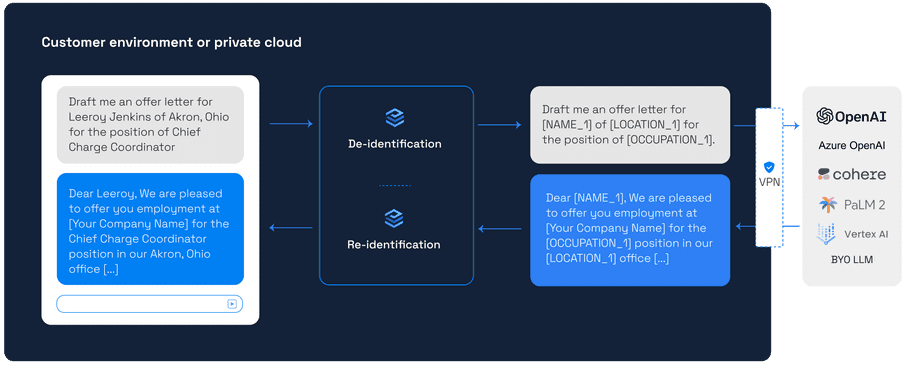PrivateGPT User Guide
This guide details how to use PrivateGPT, Private AI's privacy-preserving ChatGPT integration.
Sign Up!
First off, if you haven't already, sign up for PrivateGPT here!
In a nutshell, PrivateGPT uses Private AI's user-hosted PII identification and redaction container to redact prompts before they are sent to LLM services such as provided by OpenAI, Cohere and Google and then puts the PII back into the completions received from the LLM service. The user experience is similar to using ChatGPT, with the added benefit that no PII is ever shared with LLM Providers like OpenAI, or even leaves the user's network.
PrivateGPT comes in two flavours: a chat UI for end users (similar to chat.openai.com) and a headless / API version that allows the functionality to be built into applications and custom UIs.

In the sections linked below, you'll find more information about how PrivateGPT works and how to use it, as well as some more complex examples and best practices:
- What is PrivateGPT? provides an overview of PrivateGPT and how it works.
- Reduce Bias with PrivateGPT provides a demonstration of how using PrivateGPT can help to reduce bias in ChatGPT's responses.
- PrivateGPT FAQ contains answers to questions like where and when data is stored by PrivateGPT.
- Consult OpenAI's Best practices for prompt engineering for more tips on how to structure your prompts.
PrivateGPT API/Headless
PrivateGPT Headless Interface demonstrates how to use the headless or API version of PrivateGPT inside applications using LLMs like ChatGPT.
PrivateGPT UI
- UI Basic Use provides an overview of PrivateGPT's basic UI functionality.
- Provide Context in Your Prompt demonstrates prompting best practices.
- Redact Entities Selectively illustrates how toggling individual entity types on and off can improve your experience with PrivateGPT.
- A Note on Entity-Linking explains PrivateGPT's entity-linking capabilities and limitations.
- Admin Features
- Installation provides some high level details on how the PrivateGPT UI is installed in customer premises and user management.
If you have questions that aren't answered here, please contact us and we'll be happy to assist.